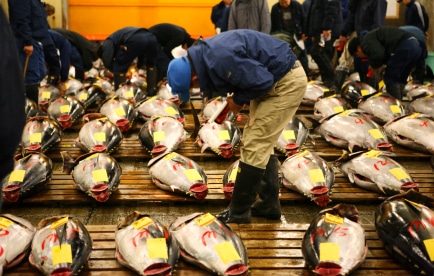The Seafood Heaven in Tsukiji

Many people are wondering why the Tsukiji fish market so popular? And where does all the seafood come from to feed a hungry Japan and the world with sushi? These questions come with a number of answers, and while the obvious one is “from the sea” a more thorough answer explores the markets through which our favorite food passes, if it makes the grade.
Top quality sushi must come from high quality fish, processed and handled appropriately, chosen carefully at the point of sale, and transported to your local sushi-ya speedily.
One weak link in this chain will result in a sub-par dining experience, a sushi meal that is so-so instead of satisfying. Few people stop to appreciate the complexity of finding the perfect fish, and getting it to the restaurant, ready for the rush of diners who expect the best.
The Volume of Sales And People is Amazing
In articles to come, we will explain the sushi supply chain in greater detail, but for now, I would like to highlight the end-all be-all of sushi sources, the largest wholesale market on Earth: the Tokyo Metropolitan Central Wholesale Market, otherwise known as the Tsukiji Fish Market.
Located (now, in 2024) in between the Sumida River and the upmarket Ginza shopping district (sometimes referred to as the Tsukiji Outer Market), in Tokyo, the Tsukiji Fish Market facilitates the sale of over 2,800 tons of more than 450 types of seafood per day, almost 1/6th of the world’s fish (as of 2010).
The market is open every day except Sunday, with the day beginning at 3:00 am, ready for the rush.
The Seafood Auction
The auction houses inspect the fish that arrive daily, calculating the potential value, and preparing for the upcoming auctions. Licensed buyers are already present, having inspected the fish themselves, determining the ones they will be bidding on, and the auction begins at 5:30 am. Once complete at 7:00 am, the buyers ship out the fish they have purchased, or cart them over to one of the many processors who have set up shop on premises.
It is an amazing sight to behold, literally tons of frozen fish being wheeled around the market, then being summarily cut into manageable pieces with giant band saws. All the while while fresh (unfrozen) products are cut into smaller pieces with giant knives (some of which are over a meter in length) called oroshi hocho (the largest at 150 cm) or hancho hocho (a shorter blade at 100 cm, which is also called maguro kiri).
By 11:00 am the market has wound down for the day and is then cleaned at 1:00 pm.
What is so Special About This Particular Seafood Market?
The Tsukiji market is not just tuna, but has just about any product from the sea that you can imagine, from shrimp to seaweed. Creatures both living and processed can be found, and the bustle is immense.
Guided tours are available, and visitors must obey strict rules when at the market to keep interruptions to a minimum. The auctions are no longer accessible to tours, but the rest of the market is available for exploration. The Tsukiji Fish Market was established in the early 1600’s, as an “Uogashi,” or riverside fish market.
The first Tokugawa shogun had invited fishermen from Tsukudajima, Osaka, to supply Edo castle with seafood in return for allowing them to fish the waters of the area. What was not supplied to the castle was then sold near the Nihonbashi Bridge. Over time, Nihonbashi Uogashi developed into a thriving market led by wholesale merchants licensed by the shogunate.
Increasing Demand Means More Markets
Expanding in size and transaction volume, the market attracted secondary markets to the area, and the vegetable markets brought with them the tradition of auctioning foodstuffs, previously not done by fish sellers. By 1923 Tokyo (Edo’s new name) had a great number of markets which were all destroyed by the Great Kanto Earthquake.
This led to the reconstruction of the three major markets in the region, Tokyo, Kanda, and Koto. The Tsukiji Fish Market in Tokyo is perhaps the most famous today, and has established a reputation of mythic proportions.
It is a place where the most expensive fish in the world is sold every year (which is really a marketing idea, and a good one), and perhaps the largest port of call for fish destined for the sushi markets of Japan, and even North America.
When I think of sushi, the Tsukiji fish market is one of the first things that comes to mind. The bustle of the trade there has become synonymous with the delivery of the freshest food the sea has to offer.
Meshiagare!
I have always been fascinated by the creation and culture of different foods, particularly sushi and sashimi in the modern era of Japanese cuisine. I am a classically trained chef and sushi connoisseur, also having operated a food service company and enjoy investigating and experimenting with food around the world.
